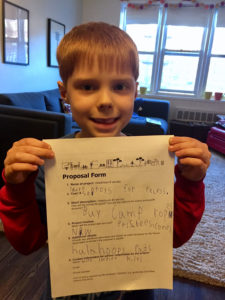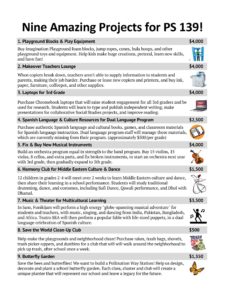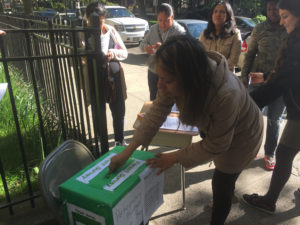
With the 2017-18 school year just around the corner, it’s time for fresh ideas to improve your local schools. One new model comes from New York City’s Primary School 139, with some special help from Participatory Budgeting Project’s Executive Director Josh Lerner – and his son Miro.
P.S.139 is a large Title I public elementary school in the heart of Brooklyn, made up of diverse families. The majority of families speak a language other than English at home, such as Spanish, Urdu, Creole, and Bangla. Nearly 1,000 students are enrolled at the school, one of whom is Josh’s son.
The school’s first experience with participatory budgeting (PB) took place this May, when the Parent Association (PA) of P.S.139 came to Josh with a problem: it had an extra $8,000 in its annual budget, but didn’t know how to spend it. The PA was being bombarded with dozens of emails about project ideas, but it had no process for deciding what to fund.
Josh was happy to help. He proposed inviting students and parents to develop and vote on ideas to spend the money, using PB.
Across the world, PB has been used to engage children as young as five years old, including in Rosario, Argentina, where Josh used to live. But most processes take place over the course of the year– Josh and the PA didn’t even have a full month, since the $8,000 had to be spent before summer vacation. They quickly developed rules for the process and solicited as many ideas as possible from parents, students, teachers, and staff, which they then turned into proposals for a ballot.

Of those final proposals, two came from students: new equipment for students to play with at recess, and a “save the world” neighborhood clean-up club – a potentially formative extracurricular activity. “PB in schools not only engages parents and caregivers,” PA board member Claire Pierce reflected, “it amplifies our children’s voices and opinions.”
Finally, it was time to vote. Over four days, nearly 600 students and parents voted, with the majority of votes from students. Never before had so many of the school’s students and parents been involved in a decision-making process.
Both student-created ideas earned enough votes to be funded. Four other ideas were also funded: a butterfly garden, laptops for 3rd grade classes, Spanish language resources and materials for the school’s Dual Language program, and new musical instruments.
Now, all that’s left is implementation, which has been a new and productive challenge, according to Josh: “One basic issue that’s come up has been around how to purchase things… Who pays for what materials? Where does stuff get delivered and stored? How does it get used? So it’s raising lots of good questions.” The process increased familiarity with school rules – and uncovered some policies that needed improvement.
Thanks to the process, more parents than ever are donating to the school and getting involved with the PA. The PA is relatively new and had not done much fundraising before, but it tried a fundraising appeal for the PB vote, asking families to contribute so that more projects on the ballot could be funded. P.S.139 families donated and raised $2,282 – the most successful donation appeal ever – which was then matched by Principal Mary McDonald. And so many parents ran for the PA board that it expanded the number of board positions. “I feel like participation in the Parent Association will snowball next year,” said PA board member Liz Fleischman. “The excitement and hopefulness created by participatory budgeting was golden!”

Increased parent and student engagement was a boon for teachers and administrators as well: A community which is invested in its school will contribute to making the school an inclusive, supportive, intellectually stimulating environment. “Participatory budgeting has been a fantastic experience, generating brilliant new ideas to improve the school and amazing engagement from parents and students,” said principal McDonald. “I look forward to growing this at our school!”
Students, meanwhile, got a unique opportunity to learn about democracy by doing democracy, an opportunity they cherished. Josh sat in on the voting in his son’s kindergarten class, and when he returned to the class a week later, another student ran up to him and cried out, “Voting! I LOVE voting!”
Josh remembers that moment fondly. “That gave a taste of the power that this can have in schools,” he says. “This was a fun and meaningful experience for the students that made them want to get involved in democracy.”
This school year, there will be more time to develop ideas and engage students. Nonetheless, the experience of P.S.139 showed that even in a condensed timeframe, students and parents can provide fresh ideas to solve school problems.
PB is an engaging, meaningful, and educational experience for parents, students, and administrators, and with the new school year beginning, now is the perfect time to get the process started. Thanks to our PB in Schools guide and video, PB in your school is just a click away.
